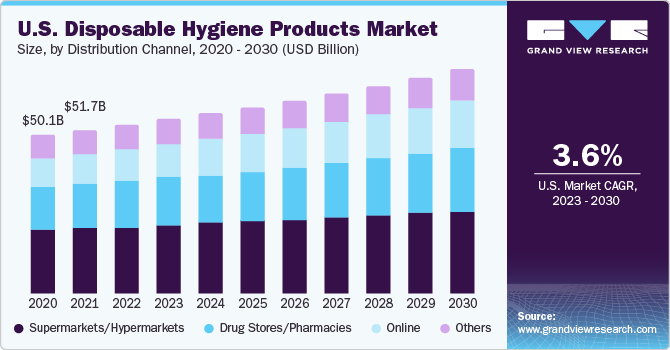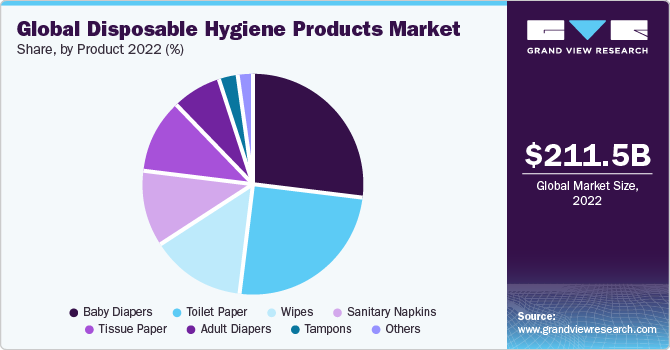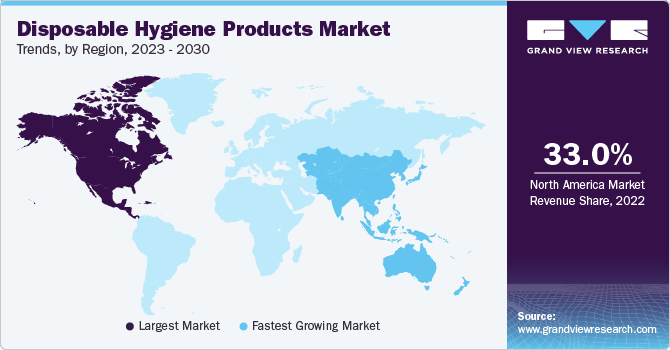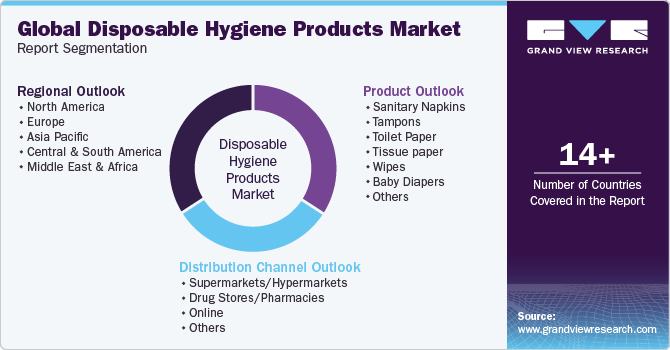
Disposable Hygiene Products Market Size, Share & Trends Analysis Report By Product (Tampons, Toilet Paper), By Distribution Channel (Hypermarkets/Supermarkets, Online), By Region, And Segment Forecasts, 2023 - 2030
- Report ID: GVR-4-68040-144-8
- Number of Pages: 85
- Format: Electronic (PDF)
- Historical Range: 2017 - 2021
- Industry:Consumer Goods
Market Size & Trends
The globaldisposable hygiene products market size was estimated at USD 211.50 billion in 2022and is expected to grow at a compound annual growth rate (CAGR) of 4.6% from 2023 to 2030. The growing awareness regarding health and hygiene among consumers is a major factor driving the market growth. Moreover, enhancing menstrual hygiene among underprivileged girls and women in low- and middle-income nations has been a significant global objective. To achieve this, governments in developing regions have encouraged the adoption of disposable sanitary pads, this is expected to boosting the demand for thefeminine hygiene products. Moreover, government healthcare agencies have been implementing awareness campaigns focused on personal hygiene.

These initiatives aim to educate people about the significance of using hygiene products and are expected to bolster global product demand. An illustrative example took place in 2021 when the UK government collaborated with Unilever, Plc., a renowned global consumer goods manufacturer, to launch a worldwide personal care campaign emphasizing the importance of handwashing, personal hygiene and feminine hygiene products. These governmental endeavors are poised to support the demand for flushable gloves and toilet paper products on a global scale. Furthermore, the increasing consciousness surrounding personal care and cleanliness is a key driver for the growth of the market.
The surge in stockpiling personal care products due to COVID-19 lockdown measures worldwide positively impacted product revenues globally. Moreover, the escalating demand for sanitizing property-based flushable tissues and toilet papers from hospitals, hotels, restaurants, and other away-from-home (AFH) consumers to uphold cleanliness and prevent infections in bathroom spaces drove product demand during the pandemic.
In addition, the increasing preference for online shopping of essential daily items propelled market expansion during this pandemic period. As an example, in 2021, Essity AB, a prominent global manufacturer of personal care products, noted a 15.9% increase in online sales of its personal care goods, achieving a total of USD 1.88 billion in revenue.
The rising demand for sustainable and biodegradable materials like bamboo, organic cotton, and sugarcane in disposable hygiene products is creating new avenues for market growth. The increasing popularity of plant-based, alcohol-free incontinence products among the adult demographic, aimed at reducing skin irritation caused by chemical-based alternatives, is positively impacting global product revenues.
Moreover, the increasing preference among millennial consumers for premium, skin-friendly, and highly absorbent diapers and wipes is propelling market expansion. In the fiscal year 2022, the Procter & Gamble Company, a leading global manufacturer of premium disposable diapers andwet wipes, reported a 5% surge in sales for its baby, feminine, and family care business segment, achieved a total revenue of USD 19.74 billion. However, the utilization of chemical-based scented disposable products can lead to adverse effects such as skin rashes, colds, and headaches among consumers. This is expected to hinder the market growth over the forecast period.
Product Insights
Based on product, thebaby diaperssegment dominated the market with a revenue share of approximately 27% in 2022. Increasing awareness about child health is a significant driver in the market growth. There is a notable shift towards preferring high-quality and environmentally-friendly baby products, particularly biodegradable diapers, on a global scale. Furthermore, manufacturers are placing emphasis on creating baby diapers based on bio-friendly ingredients, a trend expected to further drive market growth in the foreseeable future.

Theadult diapers预计最快的CAG注册R of about 7.2% over the forecast period. The rising geriatric population globally along with greater accessibility to diapers, urbanization, and heightened awareness regarding the importance of maintaining hygiene conditions are major factors driving the segmental growth. Moreover, incontinence care products are seeing a growing application in medical facilities, particularly for patients grappling with acute illnesses. These diapers play a crucial role in averting leaks, regulating bodily fluids, and ensuring comfort.
Distribution Channel Insights
Based on distribution channel, the supermarkets/hypermarkets segment held a majority market share of about 41% in 2022. Many consumers enjoy the experience of shopping in- supermarkets/hypermarkets, especially during the holiday season, as it can be a fun and festive activity. Furthermore, an increasing number of supermarkets offer sustainable disposable hygiene products to cater to the growing consumer demand for eco-friendly products. By stocking and promoting sustainable options, supermarkets demonstrate their commitment to corporate social responsibility and sustainability, enhancing their brand reputation among environmentally conscious consumers.
The online channel segment is anticipated to register the fastest CAGR of about 6.4% over the forecast period. The pandemic accelerated the shift towards online sales for the market, as consumers looked for safe and convenient ways to shop and stay entertained from home. In addition, online subscription models for the purchase of disposable hygiene products have gained immense popularity among parents in recent years, as they offer convenience, cost savings, and customization. A subscription model simplifies the process of maintaining a steady supply of disposable hygiene products, making it a practical choice for busy caregivers.
Regional Insights
Based on region, North America dominated the market in 2022 with a revenue share of approximately 33%. The substantial U.S. and Canadian populations' need for personal care items including wipes, diapers, razors, blades, feminine hygiene products and others for everyday hygiene is what primarily drives the North American market. According to information provided by the U.S. Census Bureau, a federal government body in the United States, sales of health and personal care stores in the country reached USD 4.3 million in September 2021, an increase of 0.5% over August 2021.

The Asia Pacific region is anticipated to witness the fastest CAGR of 5.7% from 2023 to 2030. The increasing population, particularly in the developing economies, and their rising spending power are credited with driving the region's prosperity. In addition, the region's high infant mortality rate will contribute to increasing segment growth over the forecast period. For instance, the East Asia Forum (EAF) estimates that twelve million kids were born in China alone in 2020. Another important aspect fueling the region's growth is the accessibility of a broad range of goods at competitive rates.
Key Companies & Market Share Insights
The market for disposable hygiene products is increasingly competitive with the presence of both large- and small-scale manufacturers. Prominent players have been adopting strategies such as mergers & acquisitions, partnerships, product launches, innovation, and promotions to stay competitive in the markets.
In May 2023, Niine Sanitary Napkins, a prominent supplier of high-quality and cost-effective hygiene solutions in India, launched the nation'sbinitial biodegradable sanitary pads made from PLA (polylactic acid). These pads have received certification from CIPET (Central Institute of Petrochemicals Engineering and Technology) and boast a decomposition rate of over 90% within 175 days, with the remainder breaking down within a year.
In September 2022, Attindas Hygiene Partners launched an innovative adult disposable incontinence underwear product in North America. This innovative item remains discreet beneath clothing yet offers complete leak-proof protection of up to 100%. It incorporates Maxi Comfort ultrasonic bonding technology, resulting in a more flexible material that molds to various body shapes.
Key Disposable Hygiene Products Companies:
- Procter & Gamble
- Kimberly-Clark Corporation
- Johnson & Johnson Services, Inc.
- Essity AB
- Unicharm Corporation
- Ontex Group NV
- Domtar Corporation
- Kao Corporation
- Edgewell Personal Care Company
- Hengan International Group Co. Limited
Disposable Hygiene ProductsMarketReport Scope
Report Attribute |
Details |
Market size value in 2023 |
USD 220.60 billion |
Revenue forecast in 2030 |
USD 304.24 billion |
Growth Rate |
CAGR of 4.6% from 2023 to 2030 |
Base year for estimation |
2022 |
Historical data |
2017 - 2021 |
Forecast period |
2023 - 2030 |
Quantitative units |
Revenue in USD million/billion and CAGR from 2023 to 2030 |
Report coverage |
Revenue forecast, company ranking, competitive landscape, growth factors, and trends |
Segments covered |
Product, distribution channel, region |
Regional scope |
North America; Europe; Asia Pacific; Central & South America; Middle East & Africa |
Country scope |
U.S.; Canada; Mexico; UK; Germany; France; Italy; Spain; China; India; Japan; Indonesia; South Korea; Brazil; South Africa |
Key companies profiled |
Procter & Gamble; Kimberly-Clark Corporation; Johnson & Johnson Services, Inc.; Essity AB; Unicharm Corporation; Ontex Group NV; Domtar Corporation; Kao Corporation; Edgewell Personal Care Company; Hengan International Group Co. Limited |
Customization scope |
Free report customization (equivalent up to 8 analysts working days) with purchase. Addition or alteration to country, regional & segment scope. |
Pricing and purchase options |
Avail customized purchase options to meet your exact research needs.Explore purchase options |
Global Disposable Hygiene ProductsMarketReport Segmentation
This report forecasts revenue growth at global, regional & country levels and provides an analysis on the latest trends and opportunities in each of the sub-segments from 2017 to 2030. For this study, Grand View Research has segmented the global disposable hygiene products market report based on product, distribution channel, and region:

Product Outlook (Revenue, USD Billion, 2017 - 2030)
Sanitary Napkins
Tampons
Toilet Paper
Tissue paper
Wipes
Baby Diapers
Adult Diapers
Others
Distribution Channel Outlook (Revenue, USD Billion, 2017 - 2030)
Supermarkets/Hypermarkets
Drug Stores/Pharmacies
Online
Others
Regional Outlook (Revenue, USD Billion, 2017 - 2030)
North America
U.S.
Canada
Mexico
Europe
UK
Germany
France
Italy
Spain
Asia Pacific
China
India
Japan
Indonesia
South Korea
Central & South America (CSA)
Brazil
Middle East & Africa (MEA)
South Africa
Frequently Asked Questions About This Report
b.The global disposable hygiene products market was estimated at USD 211.50 billion in 2022 and is expected to reach USD 220.60 billion in 2023.
b.The global disposable hygiene products market is expected to grow at a compound annual growth rate of 4.6% from 2023 to 2030 to reach USD 304.24 billion by 2030.
b.North America dominated the disposable hygiene products market with a share of around 35% in 2022. The growth of the regional market is mainly driven by the presence of popular market players in the geography, combined with constant product innovation and mergers & acquisitions.
b.Some of the key players operating in the disposable hygiene products market include Procter & Gamble; Kimberly-Clark Corporation; Johnson & Johnson Services, Inc.; Essity AB; Unicharm Corporation; Ontex Group NV; Domtar Corporation; Kao Corporation; Edgewell Personal Care Company; and Hengan International Group Co. Limited.
b.Key factors that are driving the disposable hygiene products market growth include the growing awareness regarding health and hygiene among consumers , government healthcare agencies have been implementing awareness campaigns focused on personal hygiene, coupled with the rising number of working women are increasingly opting for premium tampons, panty liners, and pads to meet their menstrual management requirements.
We are committed towards customer satisfaction, and quality service.
"The quality of research they have done for us has been excellent."






